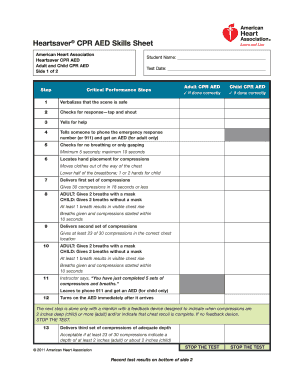
Make sure the airway is open by lifting the chin gently, then tipping the head back slowly. Gently place him/her on their back on a firm surface.
Bls skills check off cheat sheet how to#
This is for healthcare professionals only.Ĭlick here to see how to use a Bag Valve MaskĬheck your child's breathing and pulse. If the victim DOES have a pulse, but they are not breathing, you do rescue breathing. You give breaths to help give oxygen to the victim and you give chest compressions to act like their heart and help circulate the blood to the body. When you give CPR, you are giving them breaths and compressions. Remember, CPR is for those who have NO pulse and are NOT breathing. Please note that the pulse check is still expected of health care providers. Instead, if there is no response after two mouth-to-mouth breaths, begin to pump on the chest. The pulse check is no longer taught or expected of laypersons. Here is complete adult cpr, aed, bag valve sequence. Here is a full cpr scenario where the person actually is alive and talking to lifeguards stating he might have a heart attack.and he does within a few minutes. View new American Heart Association (AHA) 2020 cpr bls guideline video This is CPR and AED (BLS) and at the end use of aed. Here is a 12 minute overall video that describes the New American Heart Association "CAB" CPR and BLS and AED Guidelines Update for 2020. Continue with 30 pumps and 2 breaths until help arrives, aed is ready to shock or someone else higher trained takes over. If not breathing normally, pinch nose and cover the mouth with yours and blow until you see the chest rise. Blow: Tilt the head back and listen for breathing.

Pump at the rate of 100-120/minute, faster than once per second (Continue or Repeat).ģ.

Push down on the chest 2 to 2.4 inches 30 times right between the nipples. Pump: If the victim is still not breathing normally, coughing or moving, begin chest compressions. In most locations the emergency dispatcher can assist you with CPR instructions.Ģ. If there is no response, Call 911 and return to the victim. Call: Check the victim for unresponsiveness.


 0 kommentar(er)
0 kommentar(er)
